technical specifications FIAT MULTIPLA 2006 1.G Owners Manual
[x] Cancel search | Manufacturer: FIAT, Model Year: 2006, Model line: MULTIPLA, Model: FIAT MULTIPLA 2006 1.GPages: 266, PDF Size: 4.61 MB
Page 225 of 266
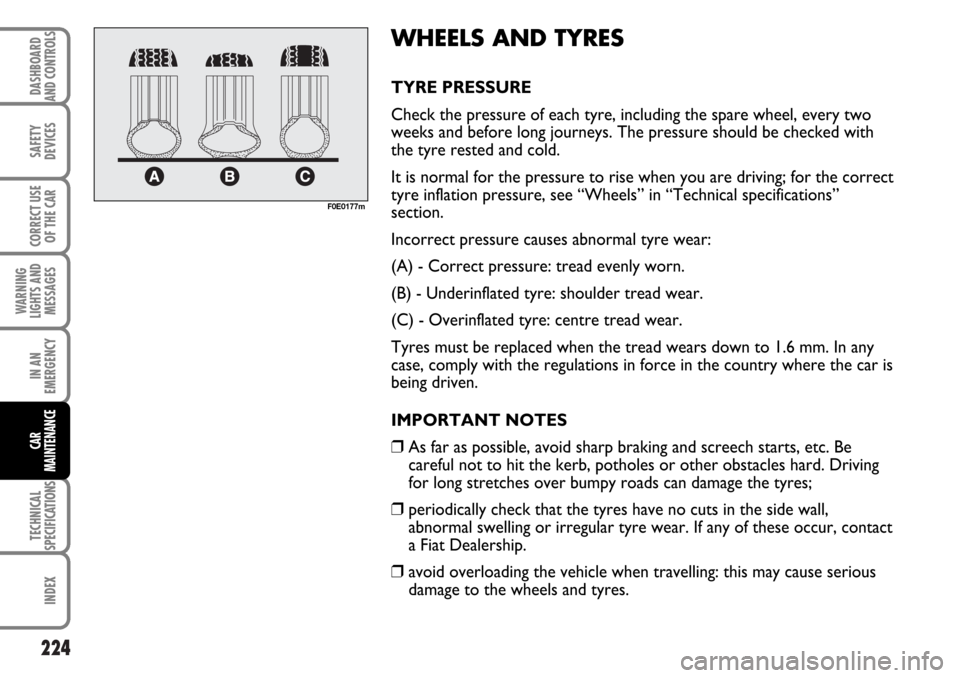
224
SAFETY
DEVICES
CORRECT USE
OF THE CAR
WARNING
LIGHTS AND
MESSAGES
IN AN
EMERGENCY
TECHNICAL
SPECIFICATIONS
INDEX
DASHBOARD
AND CONTROLS
CAR
MAINTENANCE
WHEELS AND TYRES
TYRE PRESSURE
Check the pressure of each tyre, including the spare wheel, every two
weeks and before long journeys. The pressure should be checked with
the tyre rested and cold.
It is normal for the pressure to rise when you are driving; for the correct
tyre inflation pressure, see “Wheels” in “Technical specifications”
section.
Incorrect pressure causes abnormal tyre wear:
(A) - Correct pressure: tread evenly worn.
(B) - Underinflated tyre: shoulder tread wear.
(C) - Overinflated tyre: centre tread wear.
Tyres must be replaced when the tread wears down to 1.6 mm. In any
case, comply with the regulations in force in the country where the car is
being driven.
IMPORTANT NOTES
❒As far as possible, avoid sharp braking and screech starts, etc. Be
careful not to hit the kerb, potholes or other obstacles hard. Driving
for long stretches over bumpy roads can damage the tyres;
❒periodically check that the tyres have no cuts in the side wall,
abnormal swelling or irregular tyre wear. If any of these occur, contact
a Fiat Dealership.
❒avoid overloading the vehicle when travelling: this may cause serious
damage to the wheels and tyres.
F0E0177m
Page 226 of 266
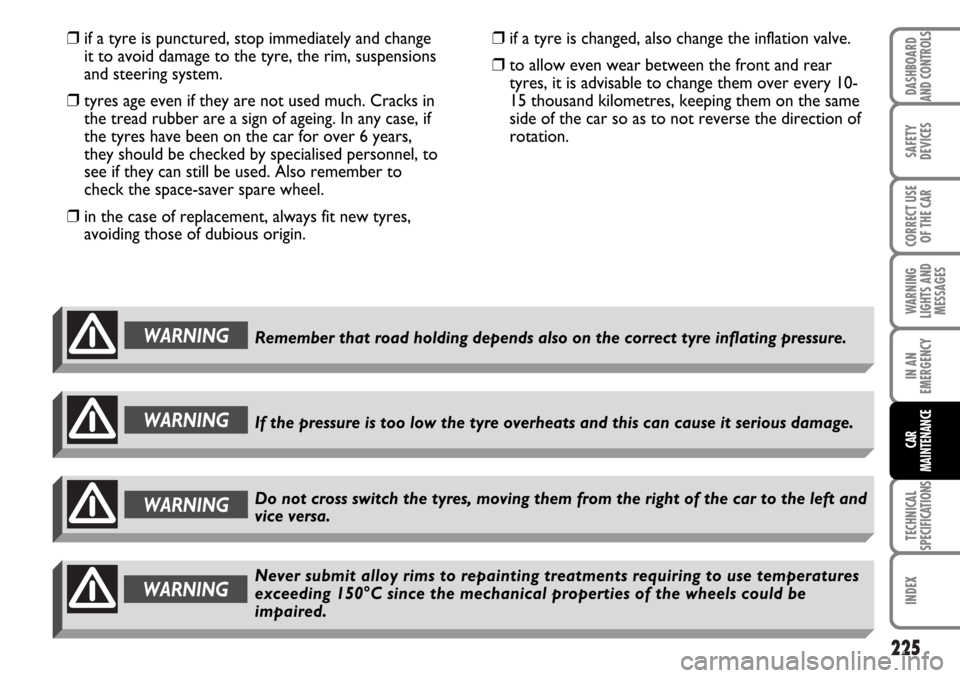
225
SAFETY
DEVICES
CORRECT USE
OF THE CAR
WARNING
LIGHTS AND
MESSAGES
TECHNICAL
SPECIFICATIONS
INDEX
DASHBOARD
AND CONTROLS
IN AN
EMERGENCY
CAR
MAINTENANCE
❒if a tyre is punctured, stop immediately and change
it to avoid damage to the tyre, the rim, suspensions
and steering system.
❒tyres age even if they are not used much. Cracks in
the tread rubber are a sign of ageing. In any case, if
the tyres have been on the car for over 6 years,
they should be checked by specialised personnel, to
see if they can still be used. Also remember to
check the space-saver spare wheel.
❒in the case of replacement, always fit new tyres,
avoiding those of dubious origin.
WARNINGRemember that road holding depends also on the correct tyre inflating pressure.
WARNINGIf the pressure is too low the tyre overheats and this can cause it serious damage.❒if a tyre is changed, also change the inflation valve.
❒to allow even wear between the front and rear
tyres, it is advisable to change them over every 10-
15 thousand kilometres, keeping them on the same
side of the car so as to not reverse the direction of
rotation.
WARNINGDo not cross switch the tyres, moving them from the right of the car to the left and
vice versa.
Never submit alloy rims to repainting treatments requiring to use temperatures
exceeding 150°C since the mechanical properties of the wheels could be
impaired.WARNING
Page 227 of 266
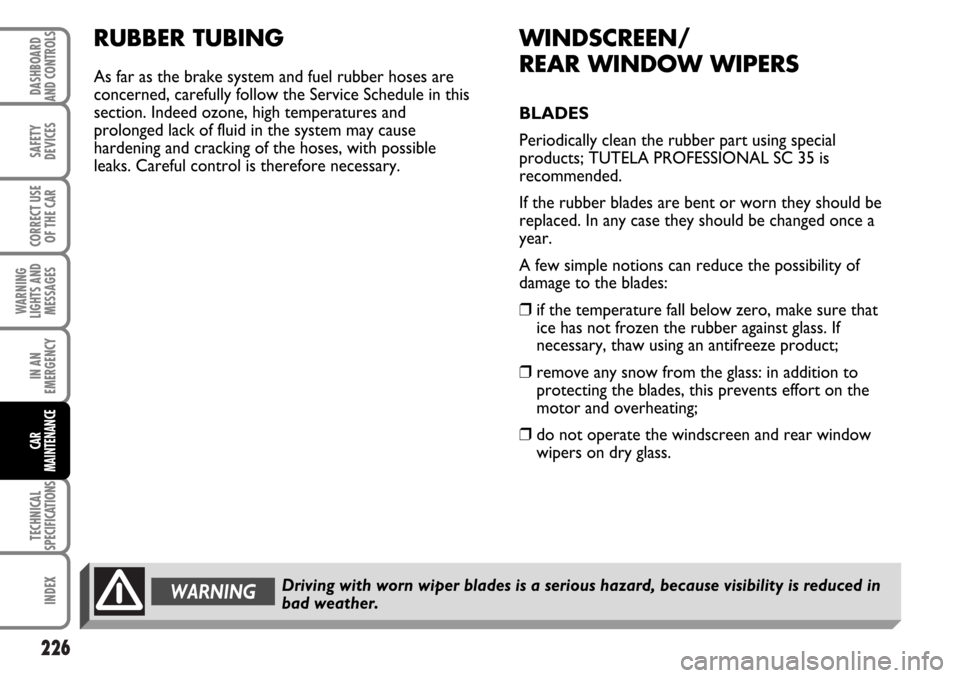
226
SAFETY
DEVICES
CORRECT USE
OF THE CAR
WARNING
LIGHTS AND
MESSAGES
IN AN
EMERGENCY
TECHNICAL
SPECIFICATIONS
INDEX
DASHBOARD
AND CONTROLS
CAR
MAINTENANCE
RUBBER TUBING
As far as the brake system and fuel rubber hoses are
concerned, carefully follow the Service Schedule in this
section. Indeed ozone, high temperatures and
prolonged lack of fluid in the system may cause
hardening and cracking of the hoses, with possible
leaks. Careful control is therefore necessary.
WINDSCREEN/
REAR WINDOW WIPERS
BLADES
Periodically clean the rubber part using special
products; TUTELA PROFESSIONAL SC 35 is
recommended.
If the rubber blades are bent or worn they should be
replaced. In any case they should be changed once a
year.
A few simple notions can reduce the possibility of
damage to the blades:
❒if the temperature fall below zero, make sure that
ice has not frozen the rubber against glass. If
necessary, thaw using an antifreeze product;
❒remove any snow from the glass: in addition to
protecting the blades, this prevents effort on the
motor and overheating;
❒do not operate the windscreen and rear window
wipers on dry glass.
WARNINGDriving with worn wiper blades is a serious hazard, because visibility is reduced in
bad weather.
Page 228 of 266
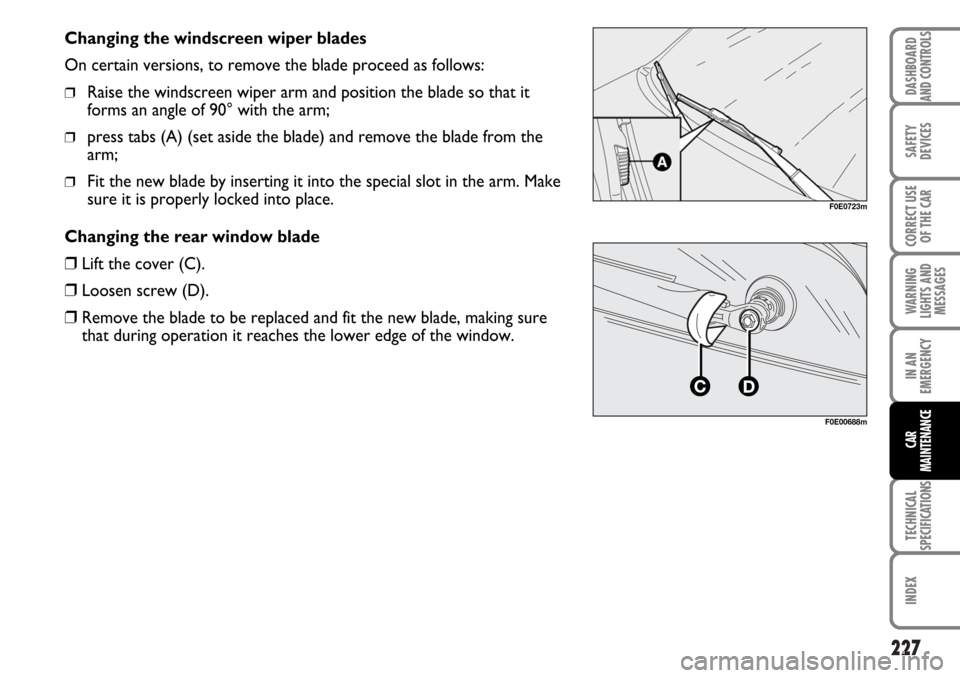
227
SAFETY
DEVICES
CORRECT USE
OF THE CAR
WARNING
LIGHTS AND
MESSAGES
TECHNICAL
SPECIFICATIONS
INDEX
DASHBOARD
AND CONTROLS
IN AN
EMERGENCY
CAR
MAINTENANCE
Changing the windscreen wiper blades
On certain versions, to remove the blade proceed as follows:
❒Raise the windscreen wiper arm and position the blade so that it
forms an angle of 90° with the arm;
❒press tabs (A) (set aside the blade) and remove the blade from the
arm;
❒Fit the new blade by inserting it into the special slot in the arm. Make
sure it is properly locked into place.
Changing the rear window blade
❒Lift the cover (C).
❒Loosen screw (D).
❒Remove the blade to be replaced and fit the new blade, making sure
that during operation it reaches the lower edge of the window.
F0E00688m
F0E0723m
Page 229 of 266
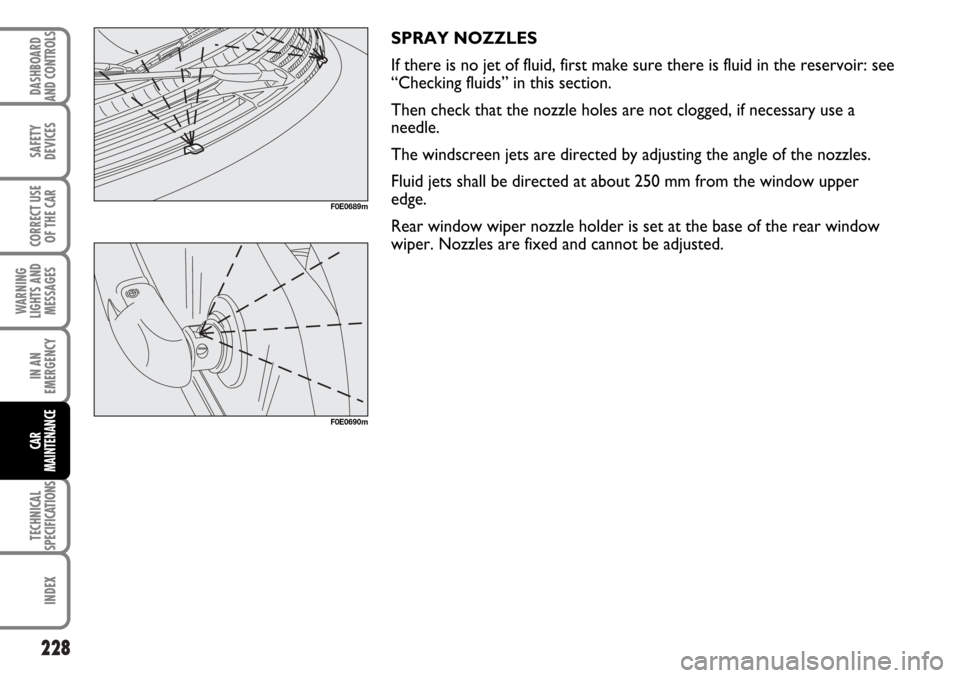
228
SAFETY
DEVICES
CORRECT USE
OF THE CAR
WARNING
LIGHTS AND
MESSAGES
IN AN
EMERGENCY
TECHNICAL
SPECIFICATIONS
INDEX
DASHBOARD
AND CONTROLS
CAR
MAINTENANCE
SPRAY NOZZLES
If there is no jet of fluid, first make sure there is fluid in the reservoir: see
“Checking fluids” in this section.
Then check that the nozzle holes are not clogged, if necessary use a
needle.
The windscreen jets are directed by adjusting the angle of the nozzles.
Fluid jets shall be directed at about 250 mm from the window upper
edge.
Rear window wiper nozzle holder is set at the base of the rear window
wiper. Nozzles are fixed and cannot be adjusted.
F0E0689m
F0E0690m
Page 230 of 266

229
SAFETY
DEVICES
CORRECT USE
OF THE CAR
WARNING
LIGHTS AND
MESSAGES
TECHNICAL
SPECIFICATIONS
INDEX
DASHBOARD
AND CONTROLS
IN AN
EMERGENCY
CAR
MAINTENANCE
BODYWORK
PROTECTION FROM ATMOSPHERIC
AGENTS
The main causes of corrosion are:
❒atmospheric pollution;
❒salty air and humidity (coastal areas, or hot humid
climates);
❒seasonal environment conditions.
In addition, the abrasiveness of dust in the atmosphere
and sand carried by the wind as well as mud and
stones kicked up by other cars must not be
underestimated.
On your Fiat Multipla, Fiat implemented the best
manufacturing technologies to effectively protect the
bodywork against corrosion.These include:
❒painting products and systems which give the car
particular resistance to corrosion and abrasion;
❒use of galvanised (or pre-treated) steel sheets, with
high resistance to corrosion;
❒spraying the underbody, engine compartment,
wheelhouse internal parts and other parts with
highly protective wax products;
❒spraying of plastic parts, with a protective function,
in the most exposed points: underdoor, inner
fender parts, edges, etc.
❒use of “open” boxed sections to prevent
condensation and pockets of moisture from
triggering rust inside.
BODY AND UNDERBODY
WARRANTY
Your Fiat Multipla is covered by warranty against
perforation due to rust of any original element of the
structure or body.
For the general terms of this warranty, refer to Fiat
Warranty Booklet.
Page 231 of 266

230
SAFETY
DEVICES
CORRECT USE
OF THE CAR
WARNING
LIGHTS AND
MESSAGES
IN AN
EMERGENCY
TECHNICAL
SPECIFICATIONS
INDEX
DASHBOARD
AND CONTROLS
CAR
MAINTENANCE
ADVICE FOR PRESERVING
THE BODYWORK
Paint
Paintwork does not only serve an aesthetic purpose,
but also protects the underlying sheet metal.
In the case of deep scrapes or scores, you are advised
to have the necessary touching up carried out
immediately to avoid the formation of rust.
Only use original products when touching up the
paintwork (see section “Technical specifications”).
Ordinary paint maintenance consists in washing at
intervals depending on the conditions and environment
of use. For example, in highly polluted areas, or if the
roads are sprayed with salt, it is wise to wash the car
more frequently.
To wash the car properly:
❒remove the aerial from the roof to prevent damages
if the car is washed in an automatic carwash;
❒wash the body using a low pressure jet of water.
❒wipe a sponge with a slightly soapy solution over
the bodywork, frequently rinsing with the sponge.❒rinse well with water and dry with a jet of air or a
chamois leather.
When drying, take particular care with the less visible
parts like door frames, bonnet and around the
headlights where water may collect. The car should
not be taken to a closed area immediately, but left in
the open so that residual water can evaporate.
Do not wash the car after it has been left in the sun or
with the bonnet hot: this may alter the shine of the
paintwork.
Exterior plastic parts must be cleaned in the same way
as the rest of the car.
Where possible, do not park under trees; the resinous
substance many species release give the paint a dull
appearance and increase the possibility of triggering
rust processes.
IMPORTANT Bird droppings must be washed off
immediately and thoroughly as the acid they contain is
particularly aggressive.
Detergents cause water pollution. Therefore the engine compartment should be washed in areas
equipped for collecting and purifying the liquid used in the washing process.
Page 232 of 266
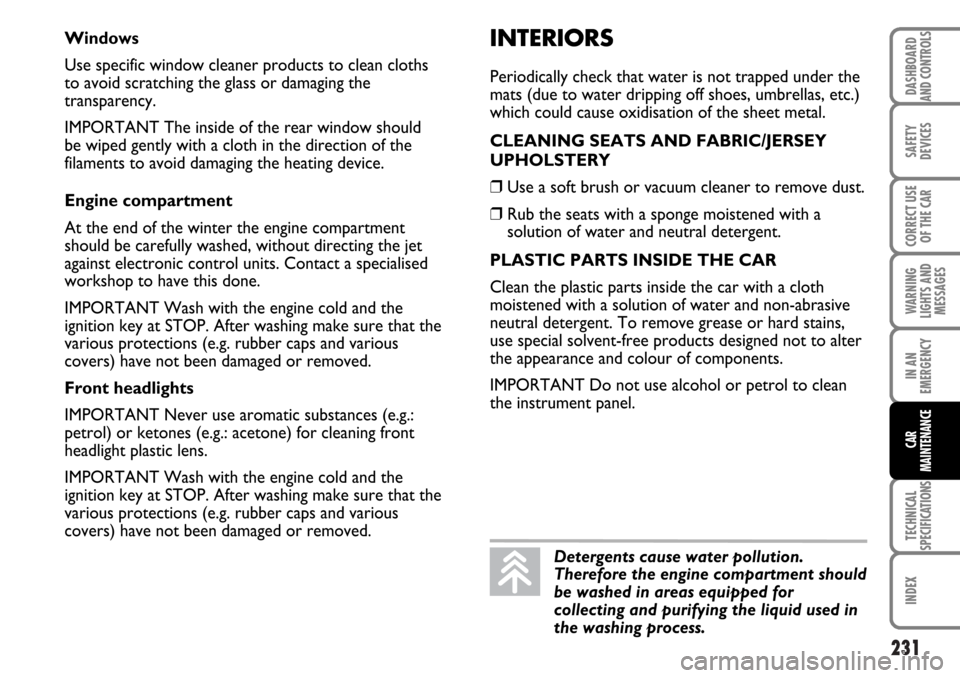
231
SAFETY
DEVICES
CORRECT USE
OF THE CAR
WARNING
LIGHTS AND
MESSAGES
TECHNICAL
SPECIFICATIONS
INDEX
DASHBOARD
AND CONTROLS
IN AN
EMERGENCY
CAR
MAINTENANCE
Windows
Use specific window cleaner products to clean cloths
to avoid scratching the glass or damaging the
transparency.
IMPORTANT The inside of the rear window should
be wiped gently with a cloth in the direction of the
filaments to avoid damaging the heating device.
Engine compartment
At the end of the winter the engine compartment
should be carefully washed, without directing the jet
against electronic control units. Contact a specialised
workshop to have this done.
IMPORTANT Wash with the engine cold and the
ignition key at STOP. After washing make sure that the
various protections (e.g. rubber caps and various
covers) have not been damaged or removed.
Front headlights
IMPORTANT Never use aromatic substances (e.g.:
petrol) or ketones (e.g.: acetone) for cleaning front
headlight plastic lens.
IMPORTANT Wash with the engine cold and the
ignition key at STOP. After washing make sure that the
various protections (e.g. rubber caps and various
covers) have not been damaged or removed.INTERIORS
Periodically check that water is not trapped under the
mats (due to water dripping off shoes, umbrellas, etc.)
which could cause oxidisation of the sheet metal.
CLEANING SEATS AND FABRIC/JERSEY
UPHOLSTERY
❒Use a soft brush or vacuum cleaner to remove dust.
❒Rub the seats with a sponge moistened with a
solution of water and neutral detergent.
PLASTIC PARTS INSIDE THE CAR
Clean the plastic parts inside the car with a cloth
moistened with a solution of water and non-abrasive
neutral detergent. To remove grease or hard stains,
use special solvent-free products designed not to alter
the appearance and colour of components.
IMPORTANT Do not use alcohol or petrol to clean
the instrument panel.
Detergents cause water pollution.
Therefore the engine compartment should
be washed in areas equipped for
collecting and purifying the liquid used in
the washing process.
Page 233 of 266
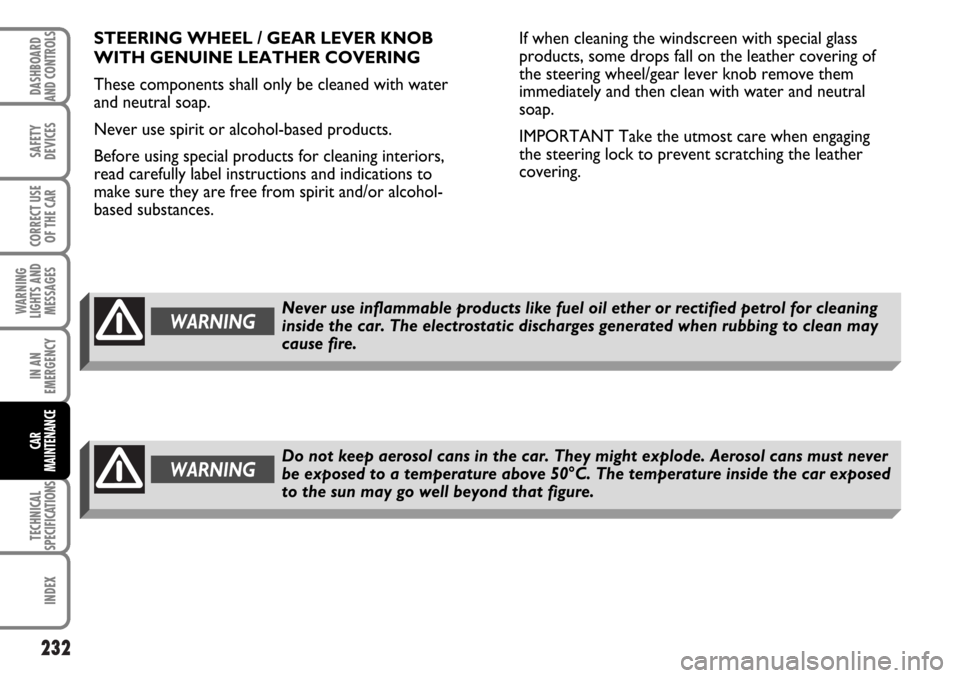
232
SAFETY
DEVICES
CORRECT USE
OF THE CAR
WARNING
LIGHTS AND
MESSAGES
IN AN
EMERGENCY
TECHNICAL
SPECIFICATIONS
INDEX
DASHBOARD
AND CONTROLS
CAR
MAINTENANCE
STEERING WHEEL / GEAR LEVER KNOB
WITH GENUINE LEATHER COVERING
These components shall only be cleaned with water
and neutral soap.
Never use spirit or alcohol-based products.
Before using special products for cleaning interiors,
read carefully label instructions and indications to
make sure they are free from spirit and/or alcohol-
based substances.If when cleaning the windscreen with special glass
products, some drops fall on the leather covering of
the steering wheel/gear lever knob remove them
immediately and then clean with water and neutral
soap.
IMPORTANT Take the utmost care when engaging
the steering lock to prevent scratching the leather
covering.
Never use inflammable products like fuel oil ether or rectified petrol for cleaning
inside the car. The electrostatic discharges generated when rubbing to clean may
cause fire.WARNING
Do not keep aerosol cans in the car. They might explode. Aerosol cans must never
be exposed to a temperature above 50°C. The temperature inside the car exposed
to the sun may go well beyond that figure. WARNING
Page 234 of 266
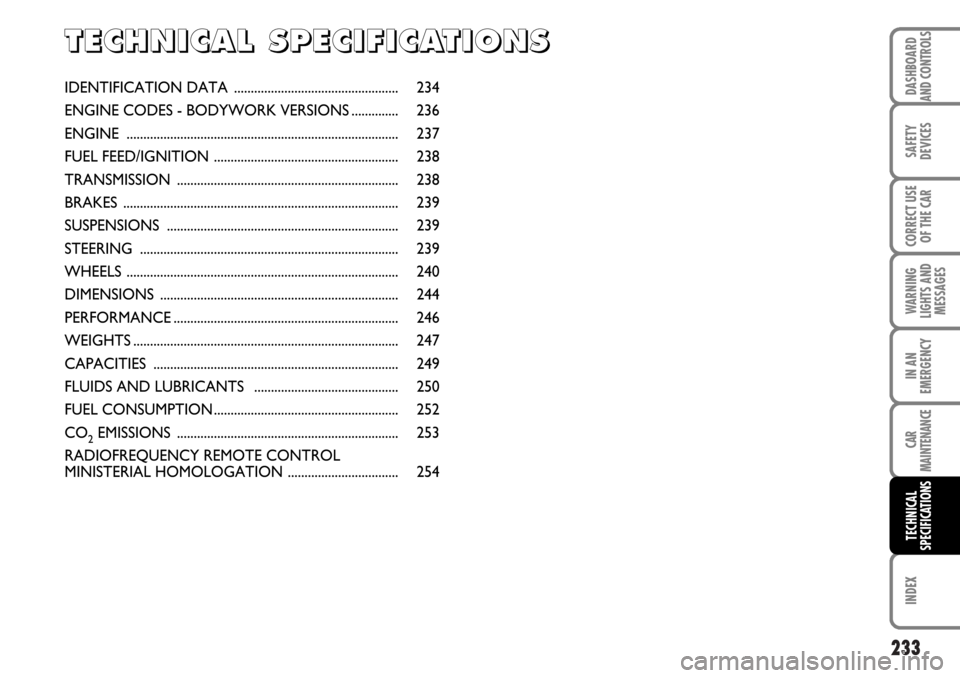
233
SAFETY
DEVICES
CORRECT USE
OF THE CAR
WARNING
LIGHTS AND
MESSAGES
CAR
MAINTENANCE
INDEX
DASHBOARD
AND CONTROLS
IN AN
EMERGENCY
TECHNICAL
SPECIFICATIONS
T T
E E
C C
H H
N N
I I
C C
A A
L L
S S
P P
E E
C C
I I
F F
I I
C C
A A
T T
I I
O O
N N
S S
IDENTIFICATION DATA ................................................. 234
ENGINE CODES - BODYWORK VERSIONS .............. 236
ENGINE ................................................................................. 237
FUEL FEED/IGNITION ....................................................... 238
TRANSMISSION .................................................................. 238
BRAKES .................................................................................. 239
SUSPENSIONS ..................................................................... 239
STEERING ............................................................................. 239
WHEELS ................................................................................. 240
DIMENSIONS ....................................................................... 244
PERFORMANCE ................................................................... 246
WEIGHTS ............................................................................... 247
CAPACITIES ......................................................................... 249
FLUIDS AND LUBRICANTS ........................................... 250
FUEL CONSUMPTION ....................................................... 252
CO
2EMISSIONS .................................................................. 253
RADIOFREQUENCY REMOTE CONTROL
MINISTERIAL HOMOLOGATION ................................. 254